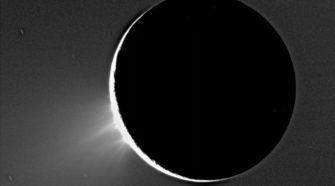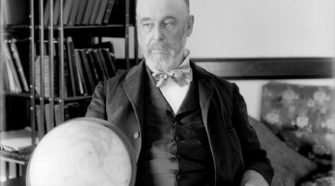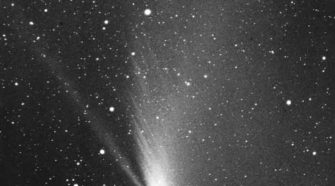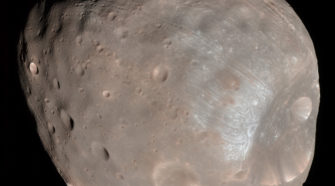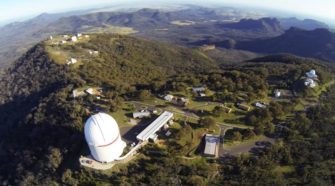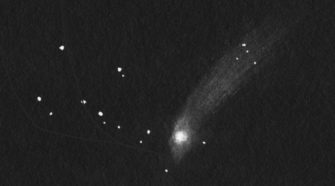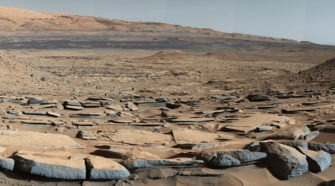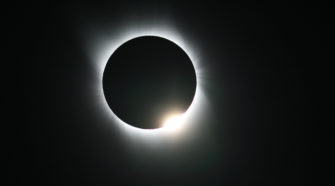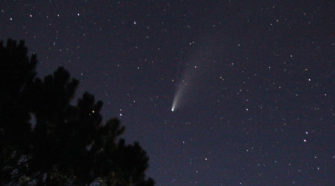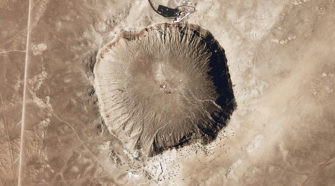Ice and Stone
Special Topic: The “Building Blocks” of Life
The “Special Topics” presentation two weeks ago discussed the possibility that signs of life might exist within certain meteorites that have been found to have come from Mars, although it did so partially within the overall context of “are we alone?” Another part of that discussion revolves around how life on Earth – and, hopefully, …
This Week in History: August 9-15
AUGUST 9, 1996: The NEAT program based in Hawaii discovers an apparent asteroid, designated 1996 PW, that is found to be traveling in a near-parabolic comet-like orbit with an approximate orbital period of 5600 years. 1996 PW was the first known long-period “Damocloid,” and these objects are discussed in a future “Special Topics” presentation. AUGUST …
Comet of the Week: Mrkos 1957d
Perihelion: 1957 August 1.44, q = 0.355 AU During the mid-20th Century the northern hemisphere went several decades without a bright naked-eye comet; what bright comets that did appear during that time were primarily visible from the southern hemisphere. This changed during 1957, when Comet Arend-Roland 1956h became bright and conspicuous during April and May, …
Special Topic: Small Planetary Moons
Throughout “Ice and Stone 2020” I have generally used the term “small bodies of the solar system” to refer to comets and asteroids. However, there is another type of “small body” that we encounter throughout the solar system: these are the smaller moons that accompany many of the major planets. The dividing line between what …
This Week in History: August 2-8
AUGUST 3, 1963: U.S. Government sensors detect an airburst explosion near the Prince Edward Islands off the southern coast of South Africa. At first it was thought that this was caused by a clandestine nuclear device tested by that nation, but later study revealed that it was caused by an incoming small stony asteroid. Airburst …
Comet of the Week: 67P/Churyomov-Gerasimenko
Perihelion: 2015 August 13.08, q = 1.243 AU There have been a handful of occasions throughout recent history when someone has discovered a comet while looking for, or examining, another one. Such an incident happened in late 1969 in the former Soviet Union, when on September 11 Svetlana Gerasimenko with the Alma Ata Observatory (in …
Special Topic: Life in Martian Meteorites?
The question as to whether or not we are alone in the universe has fascinated humanity throughout most of its history. In addition to driving many of our mythologies and stories, it has also motivated many of us, myself included, to pursue sciences like astronomy in the first place. The unambiguous discovery that life has …
This Week in History: July 26-August 1
JULY 28, 2014: The Pan-STARRS program in Hawaii discovers the centaur designated as 2014 OG392; it has an orbital period of 42.8 years and will pass perihelion in November 2021 at a heliocentric distance of 10.0 AU. An observational analysis published earlier this year indicates sustained cometary activity, however, this report was published too late …
Comet of the Week: NEOWISE C/2020 F3
Perihelion: 2020 July 3.68, q = 0.295 AU For the second time during the course of “Ice and Stone 2020” I have found it appropriate to swap out my originally intended “Comet of the Week” for a comet currently appearing in our skies. For the past three weeks, Comet NEOWISE has been putting on a …
Special Topic: Terrestrial Impact Craters
The “Special Topics” presentation six weeks ago on “Lunar and Planetary Impacts” discussed how the Italian astronomer Galileo Galilei noticed craters on the moon the first time he turned his recently-made primitive telescope towards that object. Indeed, almost any kind of optical aid, be this in the form of binoculars or a small telescope, will …

